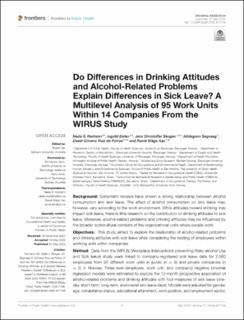| dc.description.abstract | Background: Systematic reviews have shown a strong relationship between alcohol consumption and sick leave. The effect of alcohol consumption on sick leave may, however, vary according to the work environment. While attitudes toward drinking may impact sick leave, there is little research on the contribution of drinking attitudes to sick leave. Moreover, alcohol-related problems and drinking attitudes may be influenced by the broader sociocultural contexts of the organizational units where people work. Objectives: This study aimed to explore the relationship of alcohol-related problems and drinking attitudes with sick leave while considering the nesting of employees within working units within companies. Method: Data from the WIRUS (Workplace Interventions preventing Risky alcohol Use and Sick leave) study were linked to company-registered sick leave data for 2,560 employees from 95 different work units in public (n = 9) and private companies (n = 5) in Norway. Three-level (employee, work unit, and company) negative binomial regression models were estimated to explore the 12-month prospective association of alcohol-related problems and drinking attitudes with four measures of sick leave (one-day, short-term, long-term, and overall sick leave days). Models were adjusted for gender, age, cohabitation status, educational attainment, work position, and employment sector. Hashemi et al. Alcohol-Related Individual Differences and Sick Leave Results: We observed higher variation of one-day, short-term, and overall sick leave days between companies than between work units within companies (15, 12, and 30% vs. 0, 5, and 8%, respectively). However, neither alcohol-related problems nor drinking attitudes were associated with sick leave and, thus, those variations in sick leave were not explained by alcohol-related problems or drinking attitudes. Conclusion: Our findings suggest company-level differences are more important than within company differences when explaining differences in sick leave. While alcohol-related problems or drinking attitudes were not associated with sick leave, future studies may need to explore the role of company policies, practices, or social norms in variations in sick leave rates. | |
